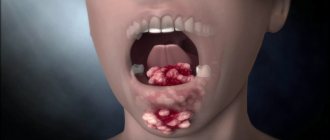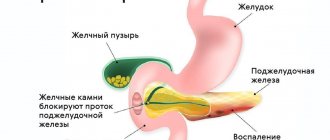Dwarfism is a significant retardation in physical development and growth due to absolute or relative deficiency of somatotropic hormone (GH, growth hormone).
The corresponding diagnosis is established when an adult woman’s height is less than 120 cm, men – 130 cm. Men suffer from dwarfism twice as often as women.
The prevalence of the disease is low; according to various sources, the incidence of dwarfism is 1:3000–1:30000. Currently, most patients with confirmed dwarfism receive hormone replacement therapy to allow them to achieve normal growth rates.
Synonyms: nanism (from the Greek nanos - dwarf), somatotropic insufficiency, nanosomia.
Dwarfism is a significant delay in growth and physical development
Causes and risk factors
The main cause of the disease is a genetic mutation inherited from parents autosomal recessively, dominantly, much less often - linked to the X chromosome, resulting in a disruption in the production of somatotropic hormone.
The following genes are mainly damaged in this disease:
- growth hormone gene GH-1;
- growth hormone receptor gene GHRH-R;
- gene that controls the maturation of pituitary cells, PROP-1;
- the Pit-1 (GHF-1) protein gene, which stimulates the expression of the growth hormone gene, as well as the prolactin gene in the pituitary gland.
The main cause of dwarfism is a genetic mutation
The development of nanism also leads to:
- idiopathic growth hormone deficiency;
- pathologies of the formation of central nervous system organs (holoprosencephaly, septo-optic dysplasia);
- violation of the formation of the pituitary gland at the stage of embryogenesis (a- or hypoplasia, ectopia).
Dwarfism as an independent disease does not have significant consequences; possible complications are associated with concomitant pathology.
In addition to being congenital, dwarfism can be a consequence of acquired growth hormone deficiency. The main reasons in this case are:
- neoplasms of the hypothalamic-pituitary axis (craniopharyngioma, hamartoma, neurofibroma, germinoma, adenoma);
- tumors of brain structures;
- traumatic brain injuries;
- iatrogenic damage to pituitary structures;
- viral and bacterial infections of brain tissue, meninges;
- autoimmune lesions of the hypothalamus, pituitary gland;
- hydrocephalus;
- transient growth hormone deficiency (constitutional or psychosomatic);
- empty sella syndrome (ESTS);
- hemorrhagic or ischemic damage to pituitary tissue;
- exposure to ionizing radiation;
- toxic damage to brain tissue.
In rare cases, nanism is a consequence of the immunity of peripheral tissues to growth hormone at its normal concentration for the following reasons:
- insufficient concentration of growth hormone receptors;
- biologically intact growth hormone;
- high concentration of somatobinding protein;
- tissue resistance to insulin-like growth factor-1 (somatomedin C), which is the most important endocrine mediator of the action of somatotropic hormone.
https://youtu.be/pWlz7wFNlIo
I'll grow big, very big!
Few people notice changes in growth as adults, but everyone sees how quickly children change. The baby begins to grow immediately after birth. In the first year he gains 25 cm! Every year this figure decreases. However, during puberty (12–13 years), a period of intense growth is observed again.
All processes in the body are influenced by hormones. The human endocrine system can be compared to an orchestra that has a conductor. All glands produce biologically active substances under the “guidance” of the hypothalamus, which are located in the brain area. The growth process is influenced by the somatotropic hormone of the pituitary gland; under its action, bones lengthen in special areas. It also releases growth factor. It is needed to strengthen muscles. Bone growth zones “close” at different ages in different people. This moment occurs for girls at about 19 years old, and for boys at 25 years old. If closure occurs earlier, then the person will not increase in length. If special zones of bones remain open for a long time, then growth, on the contrary, continues for a long time.
When the amount of somatotropic hormone in the human body decreases, dwarfism develops, and with a large amount of this hormone, a person can grow to gigantic sizes.
Forms of the disease
Depending on the cause of the disease:
- congenital and acquired nanism;
- organic (due to damage to brain structures) and idiopathic (of unknown etiology, accounting for about 70% of all cases).
In accordance with the level at which the pathology arose, the following forms are distinguished:
- hypothalamic dwarfism;
- pituitary;
- peripheral.
Depending on the severity of somatotropic insufficiency:
- isolated (production or absorption of only somatotropic hormone is impaired);
- combined (GH deficiency is combined with loss of functions of other hormones of the hypothalamic-pituitary system).
How dwarfism helped a family survive Auschwitz
The story of an artistic family of Lilliputian Jewish musicians from Romania who managed to survive Auschwitz and the monstrous experiments of Dr. Mengele.
Among the many Auschwitz prisoners who met Soviet soldiers on January 27, 1945, was the Jewish Ovitz family. Seven brothers and sisters, originally from the Romanian town of Rosvel, lived in a labor camp for almost a year. However, the main thing is not this, but the fact that the family consisted of Lilliputians and people of normal height, and during the imprisonment of Ovitz, Dr. Mengele examined him.
Background
The Ovitz family was originally from Romania. His father, named Shimshon, was a dwarf, which, however, did not prevent him from being married to tall women twice. From them he had ten children, seven of whom were Lilliputians, and three more were not.
Shimshon died in 1923, when his youngest daughter, Perla, was not yet two years old. His second wife Batya was left to raise the children alone. She understood perfectly well that dwarf children would have a hard time in life, and therefore decided to teach them music from early childhood so that they could later earn a living.
The Ovitz children turned out to be very talented, and soon they organized a family ensemble, there was a guitar and violin, drums and cello and other instruments. Not only dwarf children, but also the entire large family took part in family concerts.
Dying, Batya bequeathed to the children to always stick to each other and never separate. And all the Ovits were always together. Only one of the brothers died, who, by the way, abandoned the others.
Lilliputian groups enjoyed success in pre-war Europe. The Ovitzes began performing as a musical group in the early 1930s, calling it the “Lilliputian Troupe.” Using smaller instruments, they played in the 1930s and 1940s in Romania, Hungary and Czechoslovakia and became pop stars.
The Ovitses sang in Yiddish, Hungarian, Romanian, Russian and German.
Between tours, they all lived with their spouses in the same house, fulfilling their mother’s order not to be separated: every time someone got married, the spouse began to live with them, helping the troupe.
Doctors forbade married midgets to give birth, but one of the midgets had a daughter without any abnormalities: Shimshon’s genetic disease was not passed on to her. The family had their own car, the first in the area.
When Northern Transylvania ceded to Hungary (an ally of Nazi Germany) in September 1940, new racial laws came into force on its territory: Jews were prohibited from performing in front of non-Jews.
However, the Ovitzes managed to obtain documents that did not mention their Jewish origin, and thus they continued to give concerts until 1944.
At the same time, they still observed the Sabbath, calling in sick if necessary so as not to hold concerts on that day.
In 1944, Hungary was occupied by German troops; at the same time, the Ovitzes could no longer hide their origins and were forced to wear yellow stars on their breasts.
On April 15, the Germans gathered them together with other Jewish residents in the synagogue for further transportation to the camp. A German officer saw them there, moved them into an apartment and forced them to entertain his fellow soldiers on subsequent evenings.
This continued until May 15, when all twelve family members were sent to Auschwitz.
Auschwitz and Doctor Death's experiments
Upon arrival at Auschwitz (Auschwitz), the Ovitzes already on the platform attracted the attention of camp workers when Micky Ovitz began handing out promotional postcards for the troupe. In total, 12 family members came to the camp - from a 15-month-old child to a 58-year-old woman.
They were reported to Dr. Mengele, who settled the Ovits separately from the rest of the prisoners and released them from work. Mengele, in particular, became interested in the fact that there were both dwarfs and people of normal height in the family.
Later, the Shlomowitz family (parents and six children) joined their family and called themselves their relatives (and the Ovitzes themselves did not give them away).
Mengele, who set up a “human vivarium” in Auschwitz, had no remorse for the torture, abuse and murder of huge numbers of people. No wonder he got his nickname - Doctor Death.
His enthusiasm, ambition and cruelty set him apart even from other doctors who worked in the death camps. One of the first tasks of his career was to deal with a typhus epidemic in the women's barracks. He solved this problem by sending all 498 women to the gas chamber.
He also ordered the murder of a family of gypsies in order to examine their eyeballs. However, Mengele had other plans for the Ovitz family.
The day after arriving in Auschwitz, the little people ended up in the doctor’s laboratory. It looked like the most ordinary clinic - doctors in white coats, nothing extraordinary. It seemed to them that all the staff wanted was to take a blood test from the Ovitzes. A meager payment for saving their lives. However, bloodletting was repeated every week along with x-rays.
To monitor the dwarfs, Mengele set up a special quarter in the camp, provided them with somewhat better sanitary conditions and food than for the rest of the prisoners (after he saw that they were weakening from the usual camp food), and also allowed them to remain in their clothes and not shave off hair. He forced taller family members to carry dwarfs for experiments.
The Ovitzes, like many other camp prisoners, were subjected to various experiments.
Mengele's staff took large quantities of blood from them for tests, extracted bone marrow, pulled out teeth and hair in search of signs of hereditary diseases, exposed them to radiation, injected bacteria, poured hot and cold water into their ears and put drops in their eyes that blinded them. half a day Gynecologists examined married women and injected a scalding liquid of unknown chemical composition into their uteruses.
18-month-old Shimshon Ovitz suffered the worst test because he had normal-sized parents and was born prematurely; Mengele took blood from the veins behind his ears and from his fingers. The Ovitzes also saw two newly arrived dwarfs killed and boiled so that their bones could be displayed in a museum.
Probably Mengele himself did not know what he was looking for. There was no mention in his papers that he wanted to discover the gene for dwarfism - only routine tests and the results of an examination of the kidneys and liver.
Psychiatrists bombarded the Lilliputians with questions to find out their level of intelligence. Doctors repeatedly tested them for syphilis.
Dora Ovitz, the wife of the eldest brother, Avram, was interrogated by Mengele about her sex life with her husband.
Judging by the memoirs of the Ovits themselves, Mengele became attached to them. According to the stories of one of the sisters, Mengele called them by the names of the seven dwarves from the Disney cartoon. Ironically, one of the Auschwitz prisoners, artist Dina Gottlieb, who also made documentary sketches of the Seven Lilliputians, after the war married the leading animator of Snow White, Art Babbitt.
Symptoms
The main symptom of the disease is a lag in physical development and short stature while maintaining body proportions. Other symptoms:
- small, “doll-like” facial features;
- sinking nose bridge, massive forehead;
- rounded skull, short neck;
- miniature feet and hands;
- high voice;
- sexual infantilism;
- dryness, flabbiness of the skin, often a marbled pattern;
- emotional infantilism.
The main sign of dwarfism is short stature while maintaining body proportions
In the case of combined involvement of several hypothalamic-pituitary hormones in the pathological process, symptoms of hypothyroidism, hypogonadism, etc. are added to the clinical picture of dwarfism.
Prevention
There are no effective preventive measures to prevent dwarfism. However, the influence of harmful factors (poisons, toxins, etc.) should be avoided during pregnancy and subsequent breastfeeding . The development of the disease can be affected by injuries received during childbirth . The child should be provided with the most nutritious nutrition possible; the diet should contain foods high in vitamins and minerals. It is important to promptly treat all somatic diseases of the body.
Diagnostics
Diagnosis of the disease is primarily based on an assessment of the characteristic symptoms:
- retardation in growth and physical development, fully manifested by 2-4 years;
- growth less than 4 cm per year (usually 1-2 cm);
- maintaining the proportionality of the body structure;
- height standard deviation coefficient is less than 2.
The diagnosis of “dwarfism” is established when an adult woman’s height is less than 120 cm, and a man’s height is 130 cm.
Instrumental and laboratory studies:
- magnetic resonance and/or computed tomography (detection of structural changes in the hypothalamus and pituitary gland);
- determination of bone age using the methods of Grolich and Pyle or Tanner and Whitehouse (lag from real age by 2 or more years);
- X-ray examination of the skull (detection of sella turcica anomalies);
- somatotropin-stimulating tests - identifying the peak of GH release in the blood plasma against the background of drug provocation (insulin, clonidine, levodopa, etc.);
- determination of the level of high molecular weight somatomodin binding protein;
- determination of the concentration of insulin-like growth factor.
Very small people
Whatever we call these tiny people. Lilliputians, dwarfs, gnomes... However, wonderful creatures, as if straight from the pages of Jonathan Swift's fairy tales, are terribly offended by this. They prefer to hear “little people” addressed to them. This is understandable. This expression equalizes their rights with others - healthy and full-fledged citizens.
King and the Clown
These miniature creatures have been known since ancient times. They worked as actors and circus performers, were jesters and talking dolls, and entertained and amused the public. The Renaissance was truly the “golden age” of dwarfs in Europe. Kings, princes, wealthy aristocrats and even abbots of monasteries acquired court jesters, whose role was played by dwarfs.
The dwarf jester could say what he wanted and when he wanted: such was his privilege. At times, the jester's exceptionally caustic remarks revealed to the master the truth that other courtiers and servants tried to hide.
The little people also served as pages, messengers, confidants, and at times even spies. It was not difficult for the dwarfs to sniff out, look out and identify various kinds of intrigues.
After all, a little man could crawl through or hide where no one would notice him.
Catherine de Medici kept more than 80 dwarfs at the French court. And Philip V, King of Spain, sympathized with them so much that, on his order, the court artist Velazquez immortalized them on several of his canvases.
The ministers of the church were not inferior to the kings. For example, Pope Leo X once gave a notorious dinner served by thirty-four dwarfs, which shocked all those invited.
Small but remote
Until the beginning of the 20th century, no one knew anything about the true causes of dwarfism, and therefore scientists put forward a huge number of the most absurd versions. Now there are two scientific hypotheses: harmonious and disharmonious development of the disease.
Dwarfs of the disharmonious type are born absolutely normal, healthy people, but at some point their growth is delayed or stopped completely, which is why they remain small forever.
Such dwarfs usually have extremely large heads, disproportionately short legs, and arched and unnaturally elongated arms.
In contrast, harmonious dwarfs are already exceptionally small at the moment of birth. When they reach adulthood, they simply turn into miniature people, beautiful and proportionally built.
For a long time there was a belief that dwarfs were sterile. When it turned out that this was not so, big people came up with a new horror story - the children of dwarfs will also be short. It was only relatively recently that scientists discovered that children of harmonious dwarfs almost always give birth to healthy children of normal height. And every second child of disharmonious dwarfs, alas, is also born a dwarf.
Mysterious illness
What kind of disease is this, dwarfism? And why does it arise? So. Dwarfism is considered to be the height of an adult man below 130 centimeters and an adult woman if she does not reach 120 centimeters.
And this disease is associated with a lack of growth hormone somatotropin or a violation of its structure. This protein hormone is produced in the anterior part of the pituitary gland. From the moment of birth, it affects all cells and tissues of the body.
And the more it is in childhood and adolescence, the faster the body grows, and the taller a person will be in adulthood.
A genetic mutation called MIM 601898 is responsible for the lack of growth hormone. So, is it the trigger that leads to the disease? Most often yes. But in general, more than two hundred factors can cause the development of dwarfism.
Among them are tumor, traumatic, toxic and infectious damage to the pituitary gland, metabolic and hormonal disorders, abnormalities of chromosomal structure and even kidney diseases.
Why do genetic mutations suddenly occur in the body of a healthy person, leading to such an anomaly? Alas, scientists do not yet have an answer to this question. One way or another, two healthy parents can produce a child who will suffer from dwarfism. Conversely, two parents diagnosed with dwarfism can conceive and give birth to a completely normal baby.
In fairness, it should be noted that healthy parents very rarely give birth to children who are dwarfs. But if the mother and father themselves have any symptoms of dwarfism, the risk of having a baby with these abnormalities increases several times.
Are you weak?
Many people consider dwarfs to be almost mentally retarded. But this is far from true. Alexander Pope was and remains the greatest poet of the 18th century. His fellow writer in France, Antoine Godot, was such an outstanding personality that he managed to become a close friend of Cardinal Richelieu.
American Michael Dunn was not only a famous actor and theater school teacher, but also an opera singer.
Nowadays, you don’t have to look far for examples either. The famous “Hollywood dwarf” Verne Troyer literally conquered the whole world after his role in “Austin Powers 2”. A 33-year-old dwarf with a height of only 82 centimeters earns much more than several tall men combined.
Max MASLIN
THE MOST FAMOUS Dwarfs
The 76-centimeter Indian Ajay Kumar, the star of Indian comedies, is recognized as the smallest actor in the world, as recorded in the Guinness Book of Records. Over the past 13 years, he has appeared in more than 50 films. Married, and his wife is twice as tall as Ajay. The couple recently gave birth to a daughter of normal height.
Chen Gilyan and Li Tanyong are the smallest married couple in the world. Their height is 73 cm and 112 cm respectively.
Aditya Romeo Dev is the smallest bodybuilder in the world. His height is 80 cm and his weight is only nine kilograms, but this does not prevent him from lifting 1.5 kilogram dumbbells and being considered a bodybuilder.
STRANGE FUN
Dwarf throwing is a sport that originated in Australia and has caused outrage throughout the world.
The Lilliputian, dressed in overalls and a helmet and equipped with shields protecting his elbows and knees, is grabbed behind his back with both hands and thrown as far as possible.
There are several varieties of this “sport”: throwing against the wind and through a burning hoop. The current record holder, Jimmy Leonard, threw the dwarf Leni Gngant at a distance of 9 m 15 cm.
Source: https://xn--80audjku.xn--p1ai/articles/61815/
Treatment
Until the mid-80s of the last century, somatotropic hormone preparations obtained by extract from human pituitary tissue were used to treat children suffering from dwarfism. In 1985, this long-standing practice was officially banned due to the inability to produce the required quantities of drugs and the high risk of developing Creutzfeldt-Jakob disease in people receiving such treatment. Currently, dwarfism is treated with recombinant somatotropic hormone obtained in the laboratory using genetic engineering techniques.
During treatment, a clear dose-dependent effect is observed. An indicator of the adequacy of hormone replacement therapy is a stable annual growth: up to 13 cm (according to other sources, 8-10 cm) after the start of treatment, somewhat slowing down subsequently, fixed at 5-6 cm annually.
Currently, most patients with confirmed dwarfism receive hormone replacement therapy to allow them to achieve normal growth rates.
Active treatment is carried out until socially acceptable values of linear growth are achieved. After the growth zones are closed, the drugs are used in maintenance doses (approximately 8-9 times less than growth-stimulating doses) to ensure normal life functions.
So big, but very weak...
Gigantism, like dwarfism, can be the result of many reasons. It is easy to understand that an adult is sick. A height above 2 meters can indicate this. However, gigantism in children is more difficult to recognize. Acceleration of growth can be observed at any age, most often it occurs during the school period. Gigantism can be clearly noticed during puberty, but it can begin at 5 years of age.
Such children get sick more often, get tired quickly and have an awkward figure. Their muscles are poorly developed, they often feel their heartbeat. All these symptoms appear because the internal organs do not grow as quickly as the skeleton. With pituitary gigantism, people suffer from increased intracranial pressure and headaches. This is due to the proliferation of tumor cells and pressure on surrounding tissues.
Gigantism in children is sometimes confused with precocious puberty. In both cases, growth increases rapidly. But with early puberty, bone growth zones close quickly and growth stops. Such teenagers do not become giants.
List of sources
- Dedov I.I. Pediatric endocrinology / Dedov I.I., Peterkova V.A. - M., 2006;
- Clinical endocrinology: manual / ed. N.T. Starkova. — [3rd ed., rev. and additional] - St. Petersburg. : Peter, 2002;
- Nikitina I.L. Pediatric endocrinology: Textbook / Nikitina I.L. - Rostov-on-Don: Phoenix, 2006;
- Stroev Yu.I. Endocrinology of adolescents / Stroev Yu.I. Churilov L.P. - St. Petersburg. : ELBI-SPb, 2004;
- Shabalov M. Diagnosis and treatment of endocrine diseases in children and adolescents / Shabalov - M.: Medpress, 2003.
Forecast
The prognosis depends on the nature of the patol. process and age at which the disease began. The prognosis is more favorable for K., which developed at an older age. Patients with pituitary K. in the presence of replacement therapy usually live a long time. Regular targeted treatment leads to physical stimulation. development, helps to normalize metabolic processes, increase overall tone, disappearance or prevention of early old-age appearance.
The course and prognosis of other forms of K. depend on the diseases that caused K.






